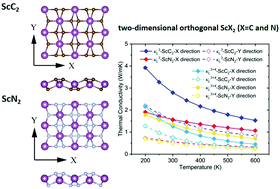Potential thermoelectric materials: first-principles prediction of low lattice thermal conductivity of two-dimensional (2D) orthogonal ScX2 (X = C and N) compounds
Abstract
Thermoelectric materials with excellent performance can efficiently and directly convert waste heat into electrical energy. In today's era, finding thermoelectric materials with excellent performance and adjusting the thermoelectric parameters are essential for the sustainable development of energy in the context of the energy crisis and global warming. Through first-principles calculations, we notice that two-dimensional (2D) orthogonal ScX2 (X = C and N) compounds show great potential in the field of thermoelectricity. Different from most materials containing C or N atoms, which are generally accompanied by high lattice thermal conductivity (TC), the 2D o-ScX2 exhibited a rather low and anisotropic lattice TC. The κ3L (the lattice thermal conductivity including the effect of three-phonon scattering and isotope scattering) of o-ScC2 along the X and Y directions are 2.79 W m−1 K−1 and 1.55 W m−1 K−1, and those of o-ScN2 are 1.57 W m−1 K−1 and 0.56 W m−1 K−1. By calculating the fourth-order interatomic force constants (IFCs), we obtain the κ3+4L with the additional four-phonon scattering effect. Our results clearly show that four-phonon scattering plays an important role in the TC of the two materials, the κ3+4L of o-ScC2 is only half of its κ3L. Furthermore, it can be noticed that the low lattice TCs of o-ScX2 (X = C and N) are the result of many factors, e.g., heavy atom doping, the strong anharmonicity caused by the vibration of Sc atoms in the out-of-plane direction and C(N) atoms in the in-plane direction, important four-phonon scattering and strongly polarized covalent bonds between X atoms and Sc atoms. Moreover, it is interesting to find that the thermal transport properties of o-ScX2 are led by a different phonon mechanism, e.g., the different TCs of o-ScC2 and o-ScN2 are determined by the anharmonic characteristic, and the harmonic characteristic plays a more important role in the anisotropy of o-ScX2 (X = C and N). In general, our research can be expected to provide important guidance for the application of o-ScX2 (X = C and N) in the thermoelectric field.



 Please wait while we load your content...
Please wait while we load your content...